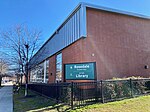Graceland Cemetery (Washington, D.C.)

Graceland Cemetery was a 30-acre (120,000 m2) cemetery located in the Carver Langston neighborhood of Washington, D.C., in the United States. It was founded in 1871 as a privately owned secular cemetery open to the public, but it primarily served the city's African American community. From 1884 to 1885, more than 1,200 bodies were transferred to Graceland Cemetery from Holmead's Burying Ground. When the cemetery encountered financial problems, the owners attempted to sell the land. This led to a lengthy and bitter battle involving the Graceland Cemetery Association, lotholders, the government of the District of Columbia, and the United States Congress. Graceland Cemetery closed by an Act of Congress on August 3, 1894. Removal of remains was also bitterly contested, but a court ruled in the summer of 1895 that the lotholders did not have the right to prevent their removal. Most of the bodies at Graceland were reinterred at Woodlawn Cemetery in Washington, D.C. A portion of Maryland Avenue NE runs through a portion of the former cemetery. Most of the cemetery was purchased by Washington Railway and Electric Company and turned into a powerhouse and streetcar operations complex. This land later became Hechinger Mall.
Excerpt from the Wikipedia article Graceland Cemetery (Washington, D.C.) (License: CC BY-SA 3.0, Authors, Images).Graceland Cemetery (Washington, D.C.)
Maryland Avenue Northeast, Washington
Geographical coordinates (GPS) Address Nearby Places Show on map
Geographical coordinates (GPS)
| Latitude | Longitude |
|---|---|
| N 38.900585 ° | E -76.981879 ° |
Address
Maryland Avenue Northeast 1501
20002 Washington
District of Columbia, United States
Open on Google Maps







